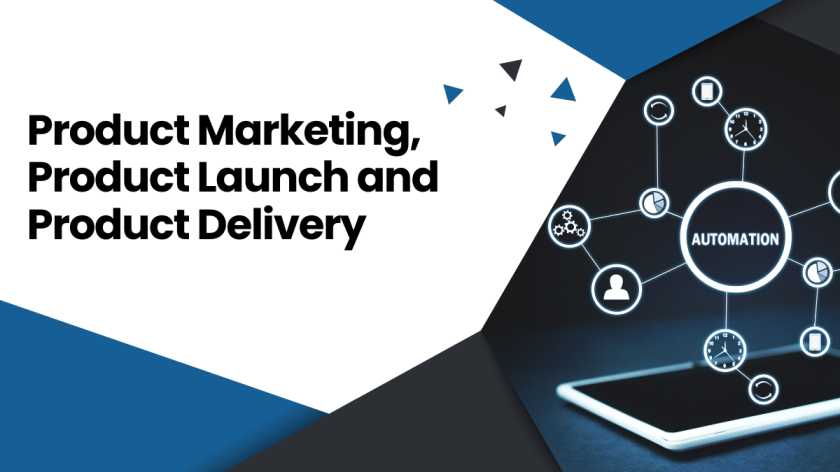Last updated on August 2nd, 2024 at 01:12 pm
Getting products to customers or clients involves a strategic process that includes product marketing, product launch, and product delivery. This is an essential part of product management courses which you need to cover if you wish to know how to become a product manager in India.
This integrated approach ensures that a product not only reaches its target audience but also creates a positive and seamless experience from awareness to delivery.
Product Marketing
Product marketing involves a set of actions aimed at guiding customers in their decision to purchase a particular product. Typically orchestrated by product marketing managers, these actions create pathways that lead customers toward making a purchase.
Crafting a Compelling Value Proposition
A value proposition is the unique reason customers choose your product or service over others. It's a concise message highlighting how your product addresses their needs or desires, answering the question: "Why choose this over something else?"
Here’s how you can create a striking value proposition:
- Identify your audience- Create a customer profile defining the user segments you'll focus on. Understand their needs, emotions, and the measurable impact of their actions. Your goal is to pinpoint a group with unmet specific needs.
- Market assessment- Examine the current market landscape. Analyse competitors, existing solutions, and their shortcomings. Gain context about the market situation.
- Problem exploration- Delve into problems, their situational contexts, and the pain points they cause. But don't just focus on issues; explore opportunities and potential gains. Start with user interviews and surveys, supplemented by initial assumptions.
- Opportunities and solutions- Identify opportunities for addressing desires and improving customer lives. Connect these opportunities to solutions that can alleviate pain points or create gains.
- Craft your value proposition- Summarise your unique solution's offering for your target audience. Emphasise how it solves core problems, provides distinct benefits, and surpasses competitors. It becomes your value proposition statement.
Identifying Target Customer Segments
Using customer segmentation, you may separate your target market into several groups based on common traits, habits, and interests.
With the help of this method, you may customise your marketing initiatives, messages, and product offerings for particular market segments, which will increase customer happiness and boost ROI.
Here are a few segmentation strategies:
- Demographic segmentation: Categorise your audience based on age, gender, income, and location. For instance, Coca-Cola tailors campaigns to different age groups, adapting messaging and products accordingly.
- Psychographic segmentation: Dive into your audience's values, interests, lifestyles, and attitudes. It helps create personalised marketing. Airbnb excels in psychographic segmentation, offering unique experiences based on travellers' preferences.
- Behavioural segmentation: Examine customer behaviours, including purchase history and brand loyalty.
Market Research and Customer Insights
| Aspect | Market Research | Customer Insights |
| Focus | Industry and market data | Consumer perceptions and preferences |
| Purpose | Addressing specific business questions | Delving into motivations, experiences, and choices |
| Perspective Shift | Understanding market trends | Shifting to a human perspective |
| Understanding | Assessing demand, competition, and loyalty | Gaining a deeper understanding of behaviour |
| Guidance | Preventing unwise decisions and guiding | Going beyond surface-level observations |
| Research Methods |
|
|
Product Launch Planning
Introducing a new product is an exhilarating venture that requires careful planning and precise execution. A thoroughly organised product launch strategy can be the key to a triumphant debut, distinguishing success from missed prospects. Solid product manager courses in India or worldwide cover launching products in great detail.
Setting Objectives and Goals
Setting goals is crucial for a successful product strategy. With clear objectives, product teams find it easier to achieve meaningful progress. While making informed guesses might work temporarily, sustained success and delivering genuine customer value demand concrete goals.
The products you develop are a reflection of your business's future success. Product goals are vital milestones in achieving that success, making them incredibly significant. They represent tangible accomplishments that bring your vision closer to reality.
Product goals offer advantages such as:
- Goal-Oriented Approach: Establishing product goals from the start ensures they remain a top priority throughout development. Amidst various ideas and stakeholder requests, goals keep you focused on what truly matters.
- Team Alignment: When engineering, marketing, sales, and other teams within your organisation align with your product goals, it fosters a shared sense of purpose. These goals unite the team around crucial objectives, illustrating how each member contributes to overall success.
Assembling the Launch Team
Adapting your launch team to match your project's size and complexity is crucial. Depending on your needs, assemble experts like product managers, marketers, engineers, designers, salespeople, and support agents.
Prioritise expertise, experience, and enthusiasm. Also, consider availability, bandwidth, and team compatibility for efficient collaboration.
- Roles and responsibilities: Once you pick your team, define their roles and duties. Assign leaders, decision-makers, communicators, executors, and supporters. Clearly outline tasks, deliverables, and deadlines. Establish transparent communication channels and coordination methods to prevent confusion or gaps.
- Effective communication and alignment: Communication is critical, especially during complex launches. Set up regular communication tools like meetings, emails, and reports. Ensure your team shares the launch's vision, goals, strategy, expectations, feedback, and insights. It fosters trust and cohesion.
Creating a Buzz and Anticipation
Creating buzz before a product or service launch is vital for success. Here are strategies to generate anticipation:
- Establish credibility: Begin by addressing the problem your offering solves and establish your credibility as the solution provider. Thought leadership and industry partnerships can help.
- Know your customer and market: Understand your target audience and market thoroughly to tailor your marketing efforts effectively.
- Plan build-up and launch: Develop a comprehensive build-up and launch plan. Utilise social media, email campaigns, webinars, and launch events to build anticipation.
- Research and teasers: Research your audience and use teaser campaigns to gauge interest. Market to interested parties and engage others to pique their curiosity.
- Leverage influencer marketing: Partner with influencers to provide authentic testimonials and user experiences, driving pre-launch buzz.
- Partner with content creators: Collaborate with creators to engage your target audience and form long-term relationships.
- Testimonials and word-of-mouth: Collect testimonials and endorsements from early users to showcase in your campaign.
- Offer value first: Build trust by demonstrating your company's value and solving customer problems before engaging in transactions.
Product Delivery Methods
Product delivery methods involve ways to efficiently and reliably get products to customers. They're crucial for customer satisfaction, cost management, and business success. Certifications for product manager roles always cover product delivery methods in depth.
Choosing the Right Distribution Channels
Distribution channels represent a product's path to consumers, including intermediaries like wholesalers and retailers or direct methods like online sales.
Channel choice depends on product traits, market characteristics, competition, and marketing implications.
Product characteristics:
- Product size, perishability, complexity, and customisation influence channel choice.
- Bulky or fragile items opt for more straightforward, shorter channels.
- Perishable goods require fast, direct routes.
- Complex or customised items use longer, interactive media.
Market characteristics:
- Market size, location, segmentation, and behaviour impact channel selection.
- A large, diverse market needs extended channels.
- Small, concentrated markets use shorter, focused channels.
- High-demand markets prefer direct, exclusive channels.
Competitive factors:
- Competition, size, and differentiation influence channel decisions.
- Many competitors favour longer channels.
- Few competitors opt for shorter channels.
- Differentiated markets may choose direct channels.
Marketing mix implications:
- Channels affect product, price, and promotion strategies.
- More extended channels need standard products, higher prices, and intensive promotion.
- Shorter channels favour customised items, lower costs, and personal publicity.
Managing Inventory and Logistics
Efficient product delivery and inventory management ensure customer satisfaction, reduce costs, and maintain smooth operations. Here's a comprehensive guide to these essential aspects:
1. Inventory management:
- Inventory classification:
- Group items based on demand, value, and turnover rate.
- Prioritise with the ABC analysis (A for high-value, high-demand; B for moderate; C for low-value, low-demand).
- Demand forecasting:
- Predict demand using historical data and market trends.
- Adopt just-in-time inventory strategies to minimise carrying costs.
- Inventory tracking:
- Employ robust tracking systems for monitoring stock levels.
- Utilise barcoding, RFID, or inventory management software for precision.
- Safety stock:
- Maintain buffer stock to accommodate unexpected demand spikes or supply interruptions.
- Inventory audits:
- Conduct regular audits to ensure data accuracy and minimise discrepancies.
2. Logistics management:
- Supply chain mapping:
- Map the entire supply chain to identify bottlenecks and optimisation opportunities.
- Supplier relationship management:
- Cultivate strong relationships with suppliers for dependable and cost-effective sourcing.
- Transportation management:
- Select suitable transportation modes (e.g., road, rail, air, sea) based on cost, speed, and distance.
- Implement route optimisation to reduce fuel consumption and delivery times.
- Warehousing:
- Opt for strategic warehouse locations to minimise shipping distances.
- Employ efficient storage and retrieval systems.
- Order fulfilment:
- Streamline order picking and packing processes.
- Integrate automation and technology to enhance order accuracy.
- Inventory visibility:
- Ensure real-time visibility into inventory levels and shipments.
- Leverage tracking and tracing technologies.
3. Technology and automation:
- Inventory management software:
- Implement advanced inventory management software for tracking, automated reordering, and data analysis.
- Transportation management systems (TMS):
- Use TMS for route optimisation, carrier selection, and shipment tracking.
- Robotics and automation:
- Explore robotics for tasks like order picking and packing.
- Sustainability and green logistics:
- Minimise carbon footprint through optimised transportation routes.
- Consider eco-friendly packaging materials.
- Implement recycling and waste reduction practices within logistics operations.
Ensuring Product Availability
Ensuring product availability involves several key steps:
1. Analyse demand patterns
Start by analysing customer demand patterns, using historical sales data, market trends, and forecasting tools to estimate stock requirements.
2. Implement inventory control systems
Implement inventory control systems, which can be manual or automated, incorporating tools like barcode scanners, RFID tags, and software for better accuracy and integration with POS, accounting, and e-commerce systems for enhanced visibility.
3. Continuously improve inventory performance
Continuously improve inventory performance by measuring fill rate, stockout rate, and turnover using tools like reports, dashboards, and KPIs to identify and address issues and inefficiencies in your inventory management.
Customer Experience and Satisfaction
Customer experience and satisfaction are about crafting positive interactions, fulfilling customer needs, and fostering loyalty for business growth.
Providing excellent customer service
Providing an exceptional customer service experience is instrumental in boosting revenue and profitability while fostering a positive work environment.
Here's how it matters and how to excel at it:
Importance of customer service:
- Revenue growth: Delighted customers are more likely to recommend your products or services to others, expanding your customer base and revenue.
- Customer retention: Resolving issues through exemplary customer service can retain customers who might otherwise switch to competitors.
- Positive work environment: Excellent customer service contributes to a pleasant workplace culture, aiding employee recruitment and retention.
Strategies for excellent customer service:
- Anticipate customer needs:
Proactively meet customer needs by using your product knowledge to offer complementary solutions before they are requested.
- Proactive issue resolution:
Build trust and maintain customer loyalty by proactively solving problems or complaints, preventing the need for customers to ask.
- Maintain composure:
Maintain composure and positivity in challenging situations, seeking collaborative solutions to uphold your brand's positive image.
- Consistent application:
Consistently apply standard solutions in customer interactions to reinforce your brand's reputation for excellent customer service.
Handling Returns and Exchanges
Crafting clear return policies
Your return, exchange, and refund guidelines must be easily accessible, transparent, and aligned with your brand values, customer expectations, and legal requirements. Display these policies prominently on your website, confirmation emails, and packing slips.
Provide straightforward instructions for initiating returns, exchanges, or refunds, including the necessary steps.
Efficient automation
Manually managing return processes is time-consuming and prone to errors. Implement automation through specialised software, such as return management systems or e-commerce platforms, to streamline operations, monitor progress, and generate reports.
Automate communication, including confirmation emails, notifications, and feedback requests, to enhance efficiency.
Exceptional customer support
Outstanding customer service is paramount when handling returns, exchanges, and refunds. Train your staff to be polite, empathetic, and responsive. Offer various communication channels, such as phone, email, chat, or social media, to promptly address customer inquiries and resolve issues.
Continuously monitor feedback and reviews to refine your policies and procedures.
Building Customer Loyalty
- Define clear goals: Establish specific objectives for your loyalty programme, like increasing retention or boosting sales, to shape its structure and rewards.
- Create customer personas: Develop detailed personas representing various segments to customise your programme effectively.
- Choose relevant rewards: Based on customer insights, select rewards like discounts, exclusive access, or cashback that appeal to all personas.
- Promote actively: Maximise programme participation through email, social media, and in-store advertising for increased engagement.
Measuring Success
Measuring success is a fundamental aspect of assessing and improving performance across various domains, from business and education to personal goals. It systematically evaluates achievements and outcomes to gauge progress and make informed decisions.
Key Performance Indicators (KPIs)
KPIs serve as vital metrics for gauging the efficiency and performance of various business facets. They offer actionable insights, steering data-driven decision-making. Below are typical KPIs spanning diverse business domains:
- Sales and revenue:
Sales and revenue metrics include monthly sales growth, customer acquisition cost (CAC), customer lifetime value (CLV), and sales conversion rate, which track monthly sales increase, new customer acquisition expenses, total customer revenue, and lead-to-customer conversion percentage, respectively.
- Marketing and customer engagement:
Website traffic measures visitor count, click-through rate (CTR) gauges link interaction, customer churn rate tracks customer loss, and social media engagement assesses likes, shares, comments, and interactions on social platforms.
- Customer satisfaction and loyalty:
These metrics include net promoter score (NPS) to gauge loyalty, customer satisfaction score (CSAT) to measure overall contentment, and retention rate to track customer longevity with your product or service.
Tracking Sales and Conversion Rates
Evaluating sales and conversion rates is vital for gauging the effectiveness of your marketing and sales endeavours. Key performance indicators in this domain offer insights into lead conversion and revenue generation. Here's an overview:
- Sales metrics encompass total revenue, periodic growth, product/service breakdown, average transaction value, channel-specific sales, customer acquisition cost (CAC), and customer lifetime value (CLV).
- Conversion rate metrics assess conversion efficiency, including conversion rate, click-through rate (CTR), lead-to-customer conversion rate, cart abandonment rate, and landing page conversion rate.
- Funnel analysis involves examining the sales funnel and conversion paths.
- Attribution models allocate conversion credit through first-touch, last-touch, and multi-touch methods.
- Customer segmentation analyses conversion rates among diverse segments.
- Mobile and e-commerce metrics track mobile conversion rates and cart-to-detail ratios.
Post-launch Evaluation
- Set clear goals
To begin, establish precise objectives for the post-launch evaluation, providing a clear direction for the assessment process.
- Collect data and metrics
Gather relevant data and metrics, including sales figures, user feedback, engagement metrics, website traffic, conversions, KPIs, and financial data such as revenue, costs, and profits.
- Customer insights
Seek user feedback to better understand their experiences: Analyse satisfaction scores, comments, and recommendations to identify common pain points and opportunities for improvement.
- Communication and reporting
Share the evaluation results and conclusions with relevant stakeholders, providing a clear action plan based on the evaluation for transparency and accountability.
- Continuous enhancement
Recognise that post-launch evaluation is an ongoing practice, and regularly review and refine assessment criteria and methods to adapt to changing circumstances and market dynamics.
Challenges and Solutions
Addressing Common Distribution Challenges
Supply chain disruptions:
One common challenge in distribution is dealing with unexpected supply chain disruptions like natural disasters or pandemics, which can lead to delays and shortages. Developing a robust supply chain management strategy is essential to overcome this challenge. It includes diversifying suppliers, maintaining safety stock, and establishing contingency plans to minimise disruptions.
Transportation costs:
Rising fuel prices and transportation costs can impact profitability. Businesses can optimise transportation routes, use route planning software, and negotiate favourable contracts with carriers to mitigate this challenge. Exploring alternative transportation modes can also lead to cost savings.
Technology integration:
Integrating various technology systems, including inventory management, order fulfilment, and tracking, can be complex. To overcome this challenge, investing in an integrated enterprise resource planning (ERP) system can streamline processes and facilitate data sharing across the supply chain.
E-commerce growth:
The rapid growth of e-commerce requires efficient order processing and fast delivery. Companies can implement automated order fulfilment systems to address this challenge, use third-party logistics providers, and optimise their e-commerce supply chain for efficiency.
Vendor relationships:
Managing relationships with vendors, distributors, and partners can be complex. Establishing clear communication channels, negotiating mutually beneficial agreements, and periodically assessing vendor performance to address this challenge effectively is essential.
Conclusion
In today's competitive landscape, successfully getting products to customers requires a deep understanding of product marketing, a strategic product launch, and efficient product delivery.
Imarticus Learning’s Professional Certificate in Product Management, offered in partnership with CEC, IIT Roorkee, is your gateway to mastering these essential skills.
With the help of this product management certification, you'll learn the skills necessary to succeed in the field of product management and make sure that your goods reach and satisfy clients. Take the next step towards a lucrative career in product management with this IIT project management course.
Visit Imarticus Learning to learn more about this product management certificate program.









